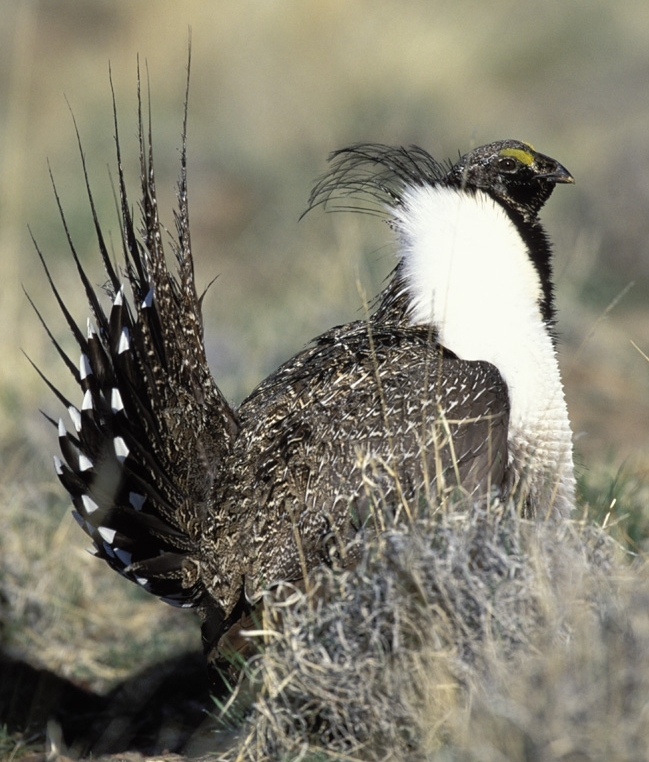- Sage-grouse
Taxobox
name = Sage-grouse

image_caption = Adult male greater sage-grouse
regnum =Animal ia
phylum =Chordata
classis =Aves
subclassis =Neornithes
superordo =Galloanserae
ordo =Galliformes
familia =Tetraonidae (disputed)
genus = "Centrocercus"
genus_authority =
subdivision_ranks =Species
subdivision ="Centrocercus minimus ""Centrocercus urophasianus "The sage-grouse are the
species in thebird genus "Centrocercus". They are largegrouse fromtemperate North America. Adults have a long, pointed tail and legs withfeather s to the toes. Like in mostGalliformes , there is pronouncedsexual dimorphism .Overview
Sage-grouse are notable for their elaborate courtship rituals. Each spring males congregate on leks and perform a "strutting display." The male Sage-grouse puffs up a large, whitish air sack on its chest, makes a soft drumming noise, and struts around with his tail feathers displayed and air sack puffed up. Groups of females observe these displays and select the most attractive males to mate with. Only a few males do most of the breeding. Males perform on leks for several hours in the early morning and evening during the spring months between February and April. Leks are generally open areas adjacent to dense sagebrush stands, and the same lek may be used by grouse for decades.
Hens build nests and lay and incubate their eggs under the cover of sagebrush. The hen uses grass and forbs between patches of sagebrush for additional cover.
Chicks can walk as soon as they are hatched and are able to fly short distances within two weeks. Within five weeks they are able to fly longer distances.
Centrocercus urophasianus is pronounced sen-tro-SER-kus YOU-row-faze-ee-AY-nus. The name of the genus is a combination of the Greek kentron, meaning point, and kerkos, tail. The specific epithet is from another Greek word for tail, oura, plus phasianos, pheasant. The noun pheasant was originally applied to a bird that was native to the valley of the Phasis River (now the Rioni River), which drains into the Black Sea from the Republic of Georgia. In the time of Lewis and Clark the word pheasant stood for "a genus of gallinaceous birds," according to lexicographer Noah Webster (1806), and the explorers often used it in that sense. Gallinaceous then referred to "domestic fowls, or the gallinae"; the family Galliformes (Latin gallus, cock, and forma, shape) now includes pheasants, grouse, turkeys, quail, and all domestic chickens. Lewis and Clark are credited with the discovery of five gallinaceous birds in addition to the sage grouse: the Columbian sharp-tailed grouse, the dusky grouse, Franklin's grouse, the Oregon ruffed grouse, and the mountain quail. [From Discovering Lewis & Clark®, http://www.lewis-clark.org © 1998-2008 VIAs Inc.]
There are two species:
*Gunnison Sage-grouse , "Centrocercus minimus"
*Greater Sage-grouse , "Centrocercus urophasianus"The
Mono Basin population may represent a third species.They are also collectively known known as sagehen, sage grouse, sage cock, sage chicken or cock of the plains [Columbia Encyclopedia, 6th ed., 2007)] . A sagehen is the mascot of the
Pomona College andPitzer College athletic teams ofClaremont, California .Footnotes
Wikimedia Foundation. 2010.
